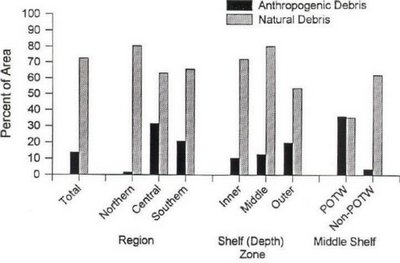 Research Areas > Marine Debris > Trawl Debris in 1998 Survey
Research Areas > Marine Debris > Trawl Debris in 1998 Survey
Project: Trawl Debris in 1998 Survey
Background and Objective
Marine debris aesthetically impairs coastal recreation areas and also threatens marine organisms through ingestion and entanglement. Many studies have documented the types and amounts of marine debris, but these have often focused on large debris found on coastal beaches. In southern California, the Los Angeles Regional Water Control Board has set a total maximum daily load of zero trash for several area watersheds; however, few studies have documented the amount of trash that ends up in the ocean. The 1994 Southern California Bight (SCB) Pilot Project initially documented the types and amounts of benthic debris on the ocean floor in southern California.
This represents the second of its kind in the SCB. The objectives of this study were to: 1) assess the distribution, type, and amount of anthropogenic and natural marine debris on the seafloor of the mainland shelf of the SCB in 1998, and 2) compare these findings to those of the 1994 SCB Pilot Project baseline study.
Status
This project was conducted in 1998.
Methods
Seafloor debris was surveyed in July-August 1998 at 314 trawl stations located on the mainland shelf of the SCB at depths of 10 to 200 m. Trawl sites were selected using a stratified random design, with strata defined by three main factors:
1) Regions: (1) northern mainland (Point Conception to Point Dume), (2) central mainland (Point Dume to Dana Point), (3) southern mainland (Dana Point to United States-Mexico international border), (4) northwest Channel Islands shelf (San Miguel Island, Santa Rosa Island, and western Santa Cruz Island), (5) southeast Channel Islands shelf (eastern Santa Cruz Island, Anacapa Island, and Santa Barbara Island), and (6) Santa Catalina Island shelf
2) Shelf Zones/Habitats: bays and harbors (5-30 m), inner shelf (5-30 m), middle shelf (31-120 m), and outer shelf (121-200 m)
3) Type of Human Influence: large POTW, small POTW, non-POTW, and river mouth areas
Trawl sampling was conducted using standardized methods described in the field operations manual prepared by the 1994 SCB Pilot Project. Trawl samples were collected with 7.6-m head-rope and 8.8-m foot-rope semiballoon otter trawls with a 1.25-cm cod-end mesh. Otter boards were 76.2 cm wide and 40.8 cm tall, and bridles were 22.9m long. Deviations within 10% of these dimensions were acceptable. Trawls were towed along isobaths for 10 min at 0.8-1.2 m/sec (1.5-2.4 kn).
Debris collected in a trawl sample was classified into 12 type categories: rocks, terrestrial vegetation, marine vegetation, lumber, plastic, metal debris, cans, glass bottles, fishing gear, tires, benthic debris, and “other” anthropogenic debris. The amount of debris in each category was reported in abundance and weight classes. Abundance classes were the following: present (1 item), low (2-10 items), moderate (11-100 items), and high (> 100 items). Weight classes included trace (0.0-0.1 kg), low (0.2-1.0 kg), moderate (1.1-10.0 kg), and high (>10.0 kg).
Findings
Natural and anthropogenic debris was widespread on the mainland shelf of southern California, but was generally found in small amounts at any given site. Natural debris occupied the same amount of area in the northern, central, and southern regions and, bathymetrically, was most common in the middle shelf zone. Natural debris was most common in the northern region, reflecting its greater availability in this less developed region. In contrast to natural debris, anthropogenic debris was highest in the southern and central regions and in bays and harbors. The higher occurrence in the southern and central regions was due to the proximity of large populations to these areas (near Los Angeles and San Diego metropolitan areas). The high occurrence of anthropogenic debris in bays and harbors was likely from land-based and marine vessel sources.

Spatial extent of anthropogenic and natural debris by percent area of the SCB
This study was part of the second region-wide monitoring effort of the SCB. The first study, in 1994, provides a baseline for comparing the amounts of debris to those found in 1998. In 1994 about 14% of the SCB had anthropogenic debris, whereas in 1998 this number increased to 23%. This may be due in part to a more extensive survey in 1998 (314 stations in 1998 compared to 114 for 1994), as well as the inclusion of bays, harbors, and islands. Trends for both studies were similar, in that most of the debris occurred in low abundance and low mass. Another similarity was the higher occurrence of anthropogenic debris in the southern and central regions (adjacent to the most populated land areas) and the middle shelf. Plastic, metal debris, and glass bottles occurred over a much larger area at large POTW areas in 1994 than in 1998; the glass bottles were most likely from recreational boat uses. Although natural debris as a whole was more evenly distributed throughout the northern, central, and southern regions in 1998 than in 1994, terrestrial vegetation showed a similar trend for both years, reflected in the fact that terrestrial debris was most commonly found in the northern region.
Though anthropogenic debris was found in about 23% of the SCB, it generally occurred with low abundance and low mass. As the impacts of marine debris on aesthetics and marine organism health become of greater concern to the public, studies such as this one will provide valuable information on the types, amounts, and location of debris in the marine benthic habitat.
Partners
This project was conducted in collaboration with more than sixty agencies, including SCCWRP’s member agencies.
This page was last updated on: 7/2/2014